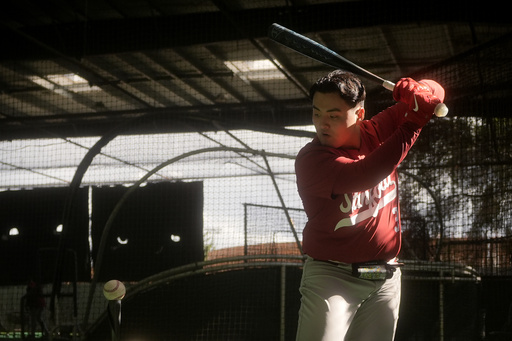
STANFORD, Calif. — Rintaro Sasaki arrives at the baseball park on his new electric bike, a brown bag of lunch in his hand, eager to enjoy a quick meal before heading to the batting cage. After facing the inconvenience of flat tires on his old bike while navigating Stanford’s large campus, his teammates encouraged him to upgrade, and now he’s delighted with his new wheels. The Japanese baseball player is thriving in his first experience with NCAA baseball, marking a significant shift from high school ball in Japan to the college scene in America, a move that could fast-track his journey toward Major League Baseball.
So far, Sasaki is blending in well and gracefully balancing the demanding responsibilities of being a student-athlete. Senior Charlie Saum often waits for Sasaki to reach out and invite him to eat at In-N-Out Burger, where Sasaki has quickly learned the popular orders, such as the double-double burger and animal-style fries. The 6-foot, 275-pound first baseman is gearing up to make his debut for Stanford on Friday at Cal State Fullerton, with his first home game set for the following week against Washington.
“I feel honored to be part of the Stanford baseball team, though I am a bit nervous too,” Sasaki shared. “Being a student-athlete involves a rigorous schedule filled with academics and practices each day. Classes are going well, and I’m truly enjoying both my studies and baseball. Although my days are long, I’m savoring every moment of my American and Stanford experiences.”
He has adapted to the intense pace of his schedule while ensuring he includes fun in the mix. For instance, during a Stanford men’s basketball game, Sasaki joined his teammates in tossing T-shirts to fans, displaying enthusiasm by pointing to the crowd before giving a thumbs-up and posing for photos with Saum.
Sasaki has fully embraced the life of a college student, even preferring to communicate in English over his native Japanese whenever possible. “That’s sick,” he exclaimed during a recent conversation, showcasing his assimilation into American slang, much to Saum’s amusement.
Saum praised Sasaki, saying, “He’s an incredible individual.” He was initially curious about how Sasaki would navigate the new culture of playing baseball as an international student. He noted that transitioning into college and baseball is challenging for anyone from the U.S., and Sasaki is the first from Japan to take such a leap. “It was surprising when he turned down a translator for his classes, expressing that he wanted to handle it independently. His determination to improve his English is truly commendable.”
From day one, Sasaki has shown a strong desire to rely on himself and only seek help when necessary, a quality Saum admires greatly. The two roomed together on road trips after Sasaki arrived in March for the spring quarter, giving him an opportunity to acclimate to American life while accompanying the team without playing. After the completion of the 2023-24 season, he joined the MLB Draft League to compete for the Trenton Thunder and later played in the Appalachian League with the Greeneville Flyboys, making a name for himself with his impressive left-handed batting.
At just 19 years old, Sasaki speaks with maturity beyond his age, demonstrating an understanding that he will face challenges and must learn to navigate them—whether in academics or on the baseball field. His parents instilled the value of having a backup plan and the importance of education in him, a principle Sasaki firmly believes in, despite not following the traditional Japanese route to baseball.
He hopes to inspire young athletes in Japan, remarking, “You can come here and find success.” His father, Hiroshi, once coached notable players such as Shohei Ohtani and Yusei Kikuchi during high school. “While I’m unsure of the impact I’ll have on Japanese high school athletes, I’m focused on pursuing my path,” Sasaki expressed in nearly flawless English. “Even in tough times, I will stick to my goals as the reason I came here was to study at Stanford—it’s about my journey and my life.”
Reflecting on his aspirations, Sasaki shared his hope that his journey could motivate others, even as he remains uncertain about his future success. Veteran coach David Esquer recognized Sasaki’s unique path, noting that he already identified Stanford as a prime program without needing recruitment in Japan.
If Sasaki’s experience can pave the way for aspiring athletes back home, both male and female, he is wholeheartedly supportive of that vision. He is indeed charting his course differently, as most top Japanese prospects usually play professionally in Japan before making their way to American major leagues. “He is willing to take this unconventional route and understands its importance,” said Esquer, who has spent several years coaching. “He embodies the spirit of those who aspire to change the world and not just focus on their own achievements. He acknowledges that his journey may inspire others to do the same.”
Sasaki will be eligible for the MLB amateur draft after his sophomore year, as he will turn 21 on April 18, 2026, complying with the requirement that a player must either be a junior or reach that age. Nevertheless, Sasaki remains grounded and focused on maximizing his collegiate experience.
“To sum him up in one word, it would be courageous,” Esquer stated. “He had the bravery to relocate to America just two weeks after high school, establishing himself in a new culture and team environment. Such courage is quite rare.”

